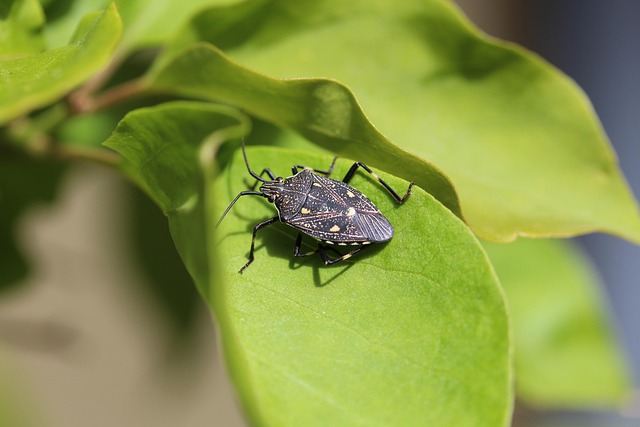Stink bugs, nocturnal insects, invade homes causing discomfort. Their lifecycle involves egg laying, nymph development feeding on plant sap, and preference for warm, moist environments. Effective residential stink bug treatment requires understanding their behavior and implementing long-term prevention strategies such as sealing entry points, maintaining clean spaces, reducing moisture, regular inspections, and swift action. Initial steps include thoroughly assessing the exterior for potential entry points like cracks in foundations or gaps around doors and windows. A robust strategy combines identifying and sealing these points with an Integrated Pest Management (IPM) approach, using non-chemical methods and minimal pesticides. Regular inspections and early intervention are vital. Consistent effort, maintenance, and professional services significantly reduce future infestations.
“Tired of dealing with stubborn stink bugs in your home? Customized plans for long-term stink bug prevention are the key to a pest-free haven. This comprehensive guide navigates you through understanding these pesky critters, from their behavior and life cycle to identifying entry points and assessing risks on your property.
Learn how to develop an effective residential stink bug treatment plan tailored to your needs and implement strategies for ongoing protection. Say goodbye to stink bugs and embrace a peaceful home environment.”
Understanding Stink Bugs: Behavior and Life Cycle
Stink bugs are small, nocturnal insects that have gained a reputation for their ability to invade homes and cause discomfort. Understanding their behavior and life cycle is crucial when it comes to effective residential stink bug treatment. These pests go through several stages during their development, starting as eggs laid by adult females on suitable surfaces like trees, shrubs, or even structures. After hatching, nymphs emerge, feeding on plant sap and growing in size. They undergo several molts before reaching the adult stage, where they continue their appetite for plant juices but also become attracted to human habitats, especially during the cooler months.
Knowing their preferences helps in devising long-term prevention strategies. Stink bugs are drawn to warmth, moisture, and food sources, so eliminating these factors is key. This includes sealing entry points, maintaining a clean home environment, and reducing moisture levels, especially in areas where they’re known to congregate, like basements or attics. Regular inspections and prompt action can significantly deter stink bug infestations, ensuring a more comfortable living space for residents.
Assessing Your Property for Entry Points and Risks
When considering a residential stink bug treatment, the first step is to meticulously assess your property for potential entry points and risks. Stink bugs are adept at infiltrating homes through even the smallest cracks and crevices. They often enter during their hunting for food or shelter, so identifying these access points is crucial for effective long-term prevention.
Inspect your home’s exterior, focusing on areas like windowsills, doors, vents, and any gaps around pipes or wires entering the building. Pay close attention to where stink bugs have been spotted before, as they tend to return to familiar haunts. By pinpointing these entry points, you can target specific areas with tailored treatments, ensuring a comprehensive residential stink bug control strategy.
Developing a Comprehensive Residential Stink Bug Treatment Plan
Developing a comprehensive residential stink bug treatment plan is essential for long-term prevention. It begins with identifying entry points where stink bugs might invade your home, such as cracks in foundations, gaps around doors and windows, or openings in screens. Once these areas are pinpointed, sealing them with caulk or other appropriate materials creates a physical barrier against stink bug intrusion. Regular inspections of the exterior of your residence should be conducted to ensure no new entry points have developed over time.
Next, implementing an integrated pest management (IPM) strategy is crucial. This involves combining various non-chemical methods like sealing entry points, maintaining good sanitation, and using traps or sticky barriers with minimal use of pesticides. Additionally, employing natural predators like spiders and ladybugs can help keep stink bug populations in check. Regular monitoring and early intervention are key; if you notice an influx of stink bugs, take immediate action to prevent a full-blown infestation.
Implementation and Maintenance: Ensuring Long-Term Prevention
Implementing a customized, long-term stink bug prevention plan requires consistent effort and maintenance. After selecting an effective treatment strategy tailored to your residential property, it’s crucial to adhere to a regular inspection schedule. Regularly checking for signs of stink bugs, such as live insects or their shed skins, allows for early detection and rapid response. This proactive approach is key to preventing reinfestations.
Proper maintenance also involves addressing any identified entry points, sealing gaps in walls, windows, and doors, and keeping the property clean and clutter-free. Ongoing monitoring and adjustments to your prevention plan will ensure that stink bugs remain at bay over time. When combined with professional residential stink bug treatment services, these diligent efforts can significantly reduce the risk of future infestations.
Implementing a customized, comprehensive residential stink bug treatment plan is key to preventing these pests from returning. By understanding their behavior and life cycle, assessing entry points, and developing tailored strategies, homeowners can achieve long-term protection. Regular maintenance and proactive measures will ensure your home remains free from stink bugs, providing peace of mind and a comfortable living environment. Remember, a well-informed approach to residential stink bug treatment is the best defense against these persistent intruders.
